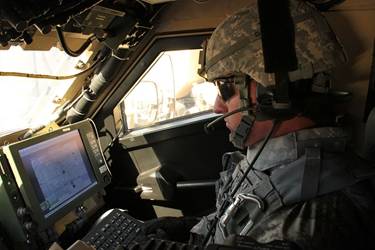General Dynamics’ WIN-T Increment 2 Program Director Todd Levine discusses how improvements to WIN-T Increment 2 will make it faster and easier for the U.S. Army to deploy its mobile battlefield network. These lighter, more agile Increment 2 components currently being tested will also result in reduced maintenance and logistics costs.
“We’re really excited about the things we have going on in collaboration with PM WIN-T Increment 2, in particular, really getting after driving down the size, cost, and complexity of the network.”
Shrinking the Central Nervous System of the WIN-T Increment 2 Mobile Network
The new and improved Tactical Communications Node-Lite (TCN-Lite) and Network Operations and Security Center-Lite (NOSC-Lite), which operate as the network’s “central nervous system,” are now designed to be integrated on a HMMWV, as opposed to the five-ton FMTV currently required. Shrinking down this technology creates a more agile network at a reduced cost.
Soldiers on board a TCN-Lite or NOSC-Lite will also have access to simplified troubleshooting wizards as well as Automated Fault Detection and correction to reduce the likelihood of operator error and decrease the frequency of maintenance. The lighter components provide increased options for transportability over the existing TCN and NOSC, including the ability to roll-on/ roll-off a C-130 or be sling loaded under a CH-47. These innovations will increase available deployment and operation locations and reduce maintenance. Soldiers using the TCN-Lite and NOSC-Lite will find their network easier to use, maintain and transport.
The “Network Filling Station” Allows Soldiers To Deploy WIN-T Faster
In collaboration with PEO C3T, WIN-T’s new Rapid Vehicle Provisioning System, or RVPS, accelerates and simplifies software upgrades through an easy-to-use web interface. Scheduled for initial fielding in early 2017, RVPS technology will enable units to be ready for a mission in just 3-4 days once deployed—down from the more than 30-day timeline of today. Soldiers will experience a number of benefits from RVPS. The reduction in deployment time will also greatly reduce the need for operator involvement in installing and configuring WIN-T assets. Coupled with an intuitive, easy to use interface simplifying the process of software deployment, it virtually eliminates operator error.
To learn more about how General Dynamics and the U.S. Army are enhancing and improving the WIN-T communications network for soldiers, download the updated WIN-T Program Report.
# # #

